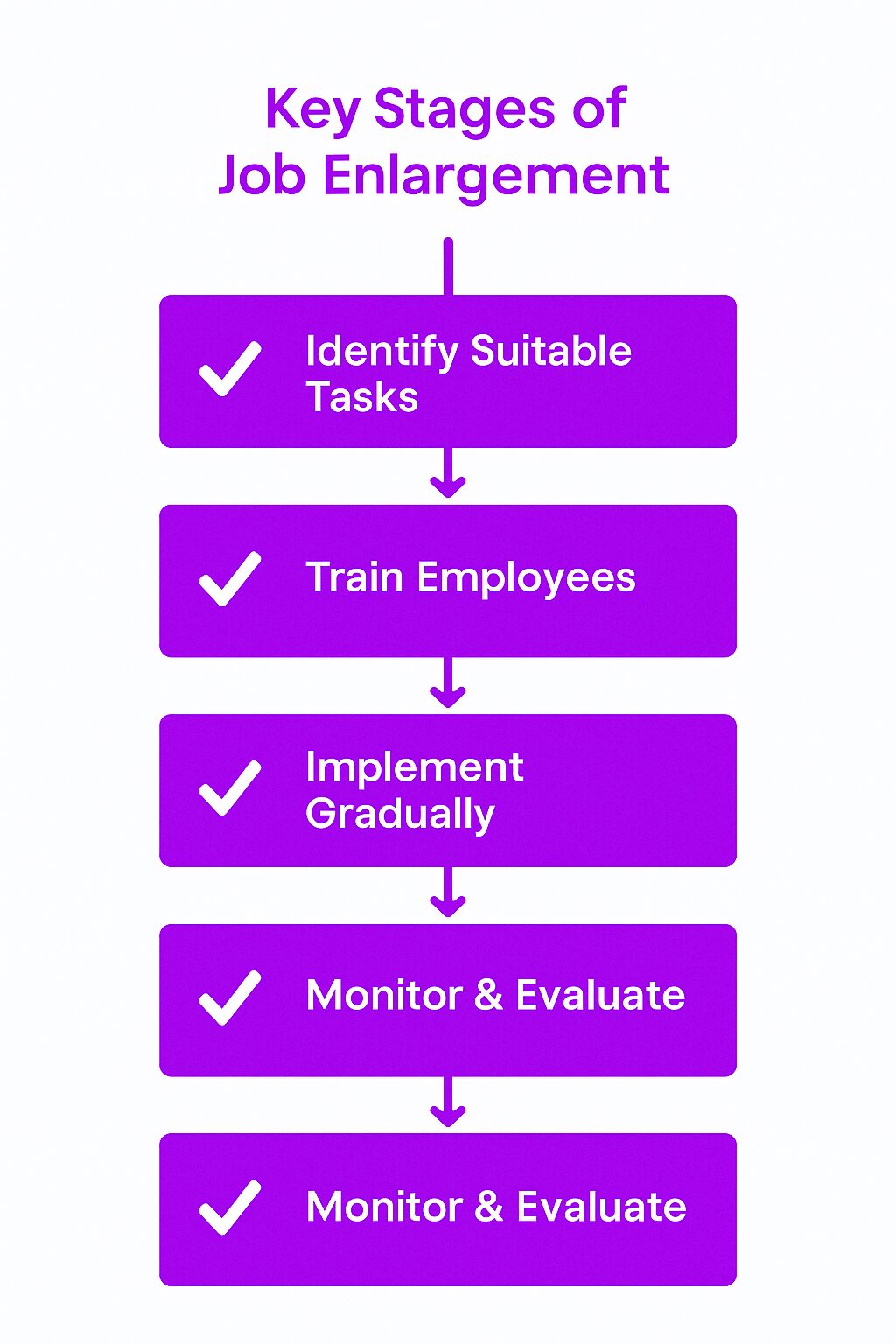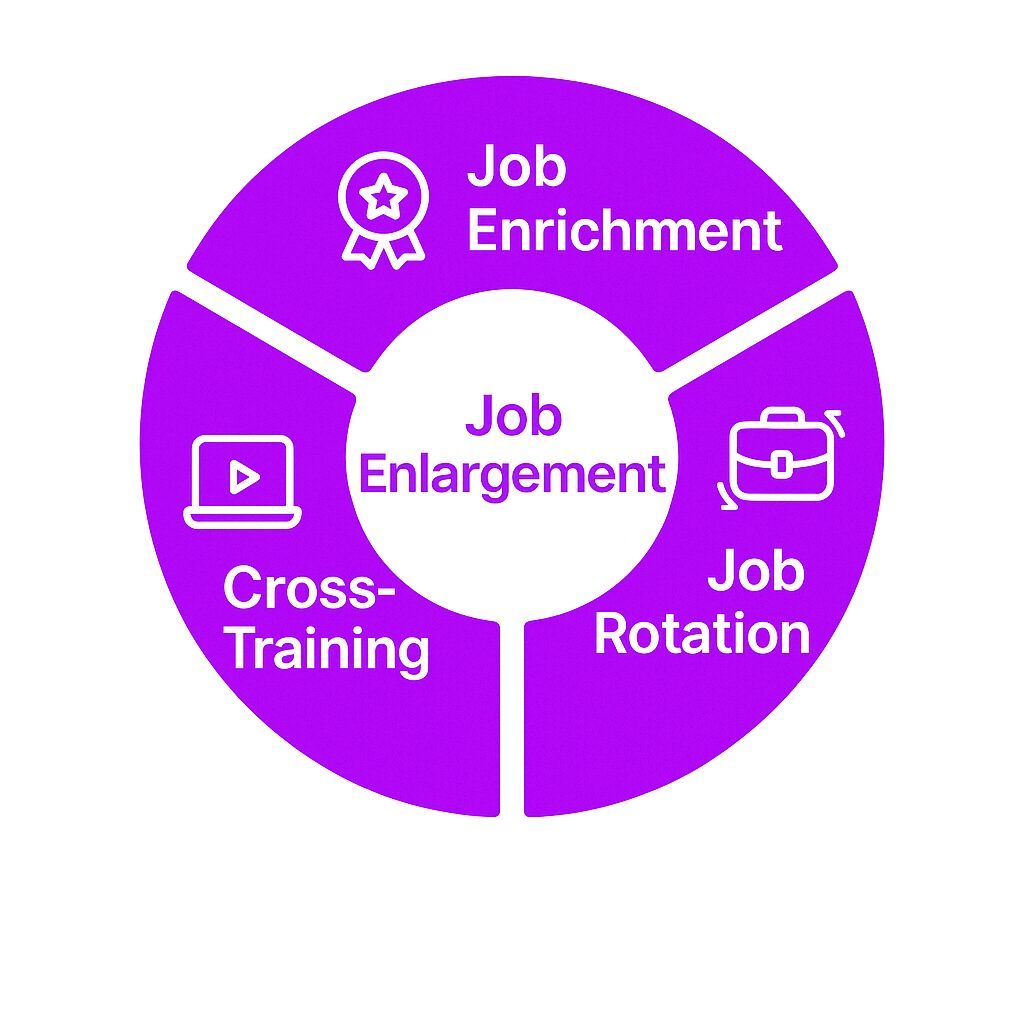What is Horizontal Job Enlargement?
Job enlargement is a workplace strategy where additional tasks of similar complexity are added to an employee’s existing role. To define job enlargement, it is the process of increasing the number of tasks assigned to an employee while keeping them at the same responsibility level. Unlike job enrichment, which increases responsibility and autonomy, job enlargement expands the range of tasks at the same skill level. The goal is to make jobs more engaging, reduce monotony, and enhance workforce flexibility without altering an employee’s rank or pay structure.
Companies use job enlargement to combat employee dissatisfaction caused by repetitive tasks. By diversifying an employee’s workload, organizations can improve motivation, efficiency, and overall job satisfaction.
How Job Enlargement Works
A company implementing job enlargement might assign a cashier additional responsibilities, such as handling customer service inquiries. A customer service representative can not only handle complaints but also conduct customer satisfaction surveys, thereby improving their understanding of customer needs and overall satisfaction. A factory worker might take on more production line job tasks beyond their usual station. This horizontal expansion broadens the role but does not necessarily deepen the level of responsibility.
Job enlargement must be strategically managed. Simply adding tasks without support or training can lead to frustration rather than engagement. Successful job enlargement initiatives consider an employee’s capacity and ensure tasks are meaningful.
Key Stages of Job Enlargement
1. Identifying Suitable Tasks
Before implementing job enlargement, managers assess which job duties can be added without overwhelming employees. These tasks must align with the employee’s existing skills to avoid steep learning curves.
2. Training and Skill Development
Although job enlargement does not require employees to take on more complex tasks, some degree of training is often necessary. Employees should receive guidance to ensure smooth transitions. Additionally, training is crucial for managing enlarged job roles effectively, as it helps address challenges such as skill gaps and employee resistance.
3. Gradual Implementation
Rolling out job enlargement in phases prevents burnout. Employees can gradually take on new responsibilities and provide feedback on workload adjustments.
4. Monitoring and Evaluation
Managers should regularly check how job enlargement impacts performance, engagement, and workload balance. Adjustments should be made based on employee feedback and productivity metrics. Monitoring these factors can help identify and address job dissatisfaction, ensuring that increased responsibilities do not negatively affect employee morale.
Why Job Enlargement is Important
Expanding an employee’s role within their skill set leads to greater job satisfaction and workplace engagement. By broadening the scope of an employee’s duties, organizations can significantly improve engagement and motivation, ultimately leading to higher levels of overall employee satisfaction. It provides variety in work, reducing the repetitive nature of specific jobs. Job enlargement also allows companies to increase operational flexibility without hiring additional staff.
For employees, job enlargement can mean new learning opportunities and a sense of accomplishment. When applied effectively, it enhances engagement without increasing workload to an unmanageable level.
Benefits of Job Enlargement
1. Reduced Job Monotony
Performing the same tasks every day can lead to boredom and disengagement. Job enlargement introduces variety, keeping employees more engaged.
Job enhancement, by evaluating current job activities and responsibilities, helps reduce monotony and identify opportunities for improvement.
2. Increased Job Satisfaction
Employees often feel more valued when their employee’s job includes a diverse set of responsibilities. Job enlargement creates a more stimulating work environment.
3. Enhanced Skill Development
Although job enlargement does not involve greater complexity, employees still gain new skills. These skills make them more versatile within the organization.
4. Improved Workforce Flexibility
Cross-training employees through job enlargement prepares them to handle different roles when needed. This adaptability is particularly beneficial in industries with fluctuating demands.
5. Higher Productivity
When employees are engaged and have a mix of tasks, they are often more productive. Job enlargement allows employees to take on additional tasks without feeling overworked.
Challenges of Job Enlargement
1. Risk of Overburdening Employees
If additional tasks are assigned without adjusting expectations, employees may feel overwhelmed. Workloads should be carefully balanced. Implementing a structured job enlargement process can help manage workloads by involving employees, providing necessary training, and ensuring a gradual transition that aligns with organizational goals.
2. Lack of Proper Training
New tasks require adequate instruction. Without proper training, employees might struggle with their expanded roles.
3. No Increase in Compensation
Since job enlargement does not typically come with a pay raise, employees might feel undervalued if additional responsibilities are added without recognition.
4. Resistance to Change
Some employees prefer clear, defined job roles. Expanding their duties may cause resistance if they do not see personal benefits.
Best Practices for Job Enlargement
1. Align with Employee Interests
Not every employee wants more tasks. Managers should discuss job enlargement opportunities with employees and align tasks with their interests.
2. Provide Training and Support
Even if new tasks are within an employee’s skill level, proper training ensures smooth transitions and prevents frustration.
3. Balance Workloads
Adding more tasks without considering workload distribution leads to burnout, especially when these tasks remain at the same level. Managers should monitor productivity levels and ensure tasks are evenly distributed.
4. Offer Recognition and Incentives
Since job enlargement does not involve promotions or pay raises, organizations should provide alternative forms of recognition. Verbal appreciation, flexible scheduling, or performance bonuses can enhance employee motivation.
5. Evaluate the Impact
Tracking employee performance and engagement before and after job enlargement helps organizations assess whether the approach is effective.
Related Concepts
1. Job Enrichment
While job enlargement expands a role horizontally, job enrichment adds complexity by increasing decision-making authority.
2. Job Rotation
Job rotation involves moving employees through different roles, exposing them to various tasks and departments.
3. Cross-Training
Cross-training allows employees to learn tasks outside their primary responsibilities, improving operational flexibility.
Real-World Examples of Job Enlargement
Retail Industry
A retail associate traditionally assigned to stocking shelves may also be tasked with managing product displays and assisting customers at checkout.
Manufacturing
An assembly line worker who normally works in one station may rotate between multiple stations to gain exposure to different aspects of production.
Customer Service
A call center representative might initially handle only incoming calls but later be assigned outbound follow-ups as well.
Additionally, conducting customer satisfaction surveys is crucial as it helps in understanding customer needs, improving employee training, and enhancing overall satisfaction within the organization.
Office Roles
An administrative assistant could expand their role to include handling social media updates and internal communications.
The Future of Job Enlargement
As organizations strive to create more flexible and engaging work environments, job enlargement will continue to play a role in workforce development. Companies must balance increased responsibilities with appropriate support to ensure employees remain motivated and productive. By implementing job enlargement effectively, businesses can improve employee retention, increase adaptability, and foster continuous skill development.






